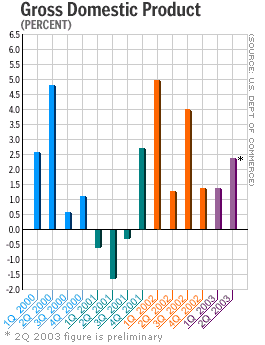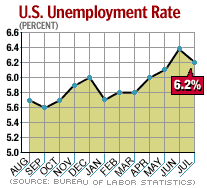NEW YORK (CNN/Money) - The U.S. economy is, by all appearances, starting to purr like a well-tuned engine. But Thursday's economic reports point out that, however fast its pistons are churning, it's still not generating any heat in the form of inflation or jobs.
On Thursday, the Commerce Department said the trade gap shrank in June, good news for growth in gross domestic product (GDP), the broadest measure of the economy. Second-quarter GDP growth will likely be revised upward, and third-quarter GDP will have a higher platform from which to climb.

But the Labor Department said weekly jobless claims crept up a bit, closer to the magical 400,000 level that indicates labor market weakness. In addition, wholesale prices were mostly flat in July, a hint that disinflation -- a slowing of inflation that some economists fear could lead to deflation, an unstoppable drop in prices that slams corporate profits -- was still hanging around.
In a speech last month, Federal Reserve Governor Ben Bernanke warned this kind of thing might happen. While most economists -- and the Fed itself -- are predicting stronger economic growth in the second half of the year, Bernanke warned such growth wouldn't necessarily bring the labor market or pricing power along for the ride.
"There appears to be some possibility that the recent trend toward disinflation will continue, primarily because of the potentially large amount of economic slack in the system," Bernanke said.
Picking up the slack
By "slack," Bernanke meant that the economy has so much supply -- with labor markets loose and factories running at less than 75 percent of their capacity, according to the latest Fed data -- that it will take a prolonged surge in demand to use it up and force the economy to go looking for more.
| Related stories
|

|
|
|
|
Only when demand exceeds supply will prices -- and wages -- start to heat up again, meaning the economy will have to charge ahead for some time before the line tightens and starts to pull jobs and prices along with it.
"It will be a long time until anybody thinks the economy is stretched and can't produce enough to match demand," said Steven Wieting, senior economist at Citigroup. "We could be dealing with it for all of 2004, certainly."
A weak labor market means a slowdown in wage growth, which pushes down demand, which undercuts consumer prices. In the 12 months that ended in June, during which the unemployment rate surged to 6.4 percent from 5.8 percent, the Labor Department's consumer price index (CPI) rose just 1.5 percent, the weakest rate since the 1960s.

Economists, on average, expect the Labor Department to report Friday that CPI rose just 0.1 percent in July, excluding food and energy, after being flat in June, according to a Reuters poll.
And the labor market seems unlikely to expand for some time, despite a surge in economic growth, as employers will wait until they're absolutely certain the economy is on the mend before they start hiring in great numbers.
"We expect the labor market in the next five months will first stabilize and eventually improve, but it's probably just stabilizing now," said former Fed economist Wayne Ayers, now chief economist at Fleet Boston Financial. "We're still six to eight months away from convincing upturns in job creation."
Ayers and many other economists believe consumers, who are already surly about the labor market's prolonged slump -- it's still in the middle of its longest period without net year-over-year job creation since 1944-46 -- can hang on and keep spending until the labor market recovers.
Other economists, however, worry the recovery will be tepid -- in part because many companies are using technology to get more work out of their employees and because some companies are looking overseas for cheaper labor.
"Increased domestic demand is now being satisfied by supply from abroad," said John Silvia, chief economist at Wachovia Securities. "Fewer domestic jobs have been created than the average historical experience and predicted by the models used by policy makers."

|

